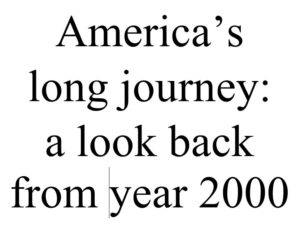
Was the revolution inevitable? Maybe, maybe not. As Thomas Paine pointed out the following year, it is merely common sense to see that an island is not going to rule a continent indefinitely. But even if separation was inevitable, did it have to come when and how it did? Did a series of Parliamentary bungles have to lead to warfare? Who knows? Let’s ask an easier question: What price conspiracy theories?
The American Revolution may be seen as an case-study in how to create what you fear. The British feared loss of political control over the North American colonies. Americans feared a conspiracy to take away their rights as Englishmen and British citizens. Both sides acted on their fears; each validated the fears of the other, and together they brought about a result that nobody planned and perhaps nobody really wanted.
As an illustrative example, look at the first armed clash between the colonists and the empire.
Here’s how the British saw it: After the Boston Tea Party, a series of events deprived the legitimate government of effective control of most of the colony of Massachusetts. (The only sizeable British armed force in Massachusetts – in all 13 colonies, actually – was stationed in the city of Boston.) The crown’s response had been to shut down the colonial government. The rebels had formed an insurgent government, and had established a militia specifically for the purpose of resisting the legitimate government and the army. Could the authorities, in all conscience, allow the insurgents to gather arms and ammunition, including cannon and shot, and wait for an inevitable assault? Would it not be better policy to gather information on where the arms were being stored, and act to confiscate them?
Americans saw it differently: To them, the Boston Tea Party and in fact all the political disturbances of the past dozen years were the result of a series of unprecedented usurpations by the British government, regardless whether the prime mover was Parliament as a whole, or the Tory majority, or the king. Quartering British troops on the people, imposing new taxes, closing the port of Boston – it was evident that they were being coerced, and could either resist or surrender the freedom they had enjoyed for more than a century and a half. The colonists were accustomed to forming and serving in militias. Militias had been their first line of defense against Indians, and then against the French. After Gage dissolved the government, the militia, rather than continuing to be used under the leadership of the colonial governor, instead were headed by the Massachusetts provincial Congress. In effect, the militia was the armed force of the de facto government.
In February, 1775, with the colony of Massachusetts officially declared to be in a state of rebellion, General Thomas Gage became both military governor and commander-in-chief of 3,000 troops that had been garrisoned in Boston. On April 14, 1775, he received orders from home: disarm the rebels and imprison their leaders. At the top of the list were Samuel Adams and John Hancock. (Note, this was 15 months before Hancock, as President of the Continental Congress, signed in large letters, so that the King could read his name without needing eyeglasses.) On the 18th, Gage ordered Lieutenant Colonel Francis Smith to take 700 men and proceed from Boston to Concord, seizing any military stores.
But the Americans knew of Gage’s instructions from London literally before he did, and Paul Revere had already ridden to Concord with a warning ten days before Smith set out. The stores were removed and distributed among surrounding towns.
What’s more – incredibly – the Americans knew the details of the secret mission of April 19 even though neither the officers nor the rank and file did. On the night of April 18, 1775, Joseph Warren (who had two months to live) sent William Dawes and Paul Revere to warn Lexington that British regulars were coming their way. In Lexington, they met Hancock and Adams and decided that Concord was the main target. Revere, Dawes, and Samuel Prescott set out to warn Concord. Revere and Dawes were captured, but Prescott made it, and his warning triggered a recently developed system of “alarm and muster” that alerted neighboring villages to know to muster their militias because regulars in numbers greater than 500 were leaving Boston. This system used express riders, bells, drums, alarm guns, bonfires, lots of things. So effective was it that people in towns 25 miles from Boston were aware of the British army’s movements while they were still unloading boats in Cambridge!
You know the bare bones of the story from here. The army got to Lexington, a few shots were fired at sunrise, the outnumbered militia saved themselves by falling back (rightly) and the army proceeded to Concord. They didn’t find any supplies to confiscate, but at the old North Bridge three companies found themselves outnumbered and outfought by 500 militiamen. Then, the army had to fight its way all the way back to Boston, as more militia continued to arrive. Reinforcements from Boston saved the expedition, but the militia followed them all the way. All told, of the 700 men sent out, they had lost 73 killed and 174 wounded, with 53 men missing. The Americans had lost 49 killed and 39 wounded. (And 5 missing. One wonders about that.)
The next day, the British were faced with militia numbering 15,000 men, blocking what was then the only land access to the peninsular city. (The back bay would not be filled in for many decades.) The siege of Boston had begun. Bunker Hill would follow, and then Washington would arrive to take command of the Continental army, demonstrating that Boston was not going to be left to face the British alone.